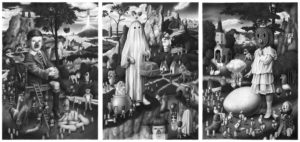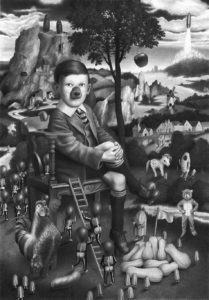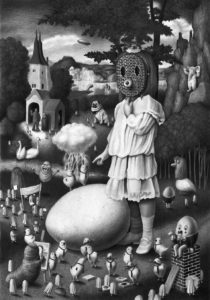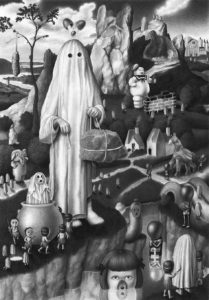 The Egg Triptych
The Egg Triptych
Amandine Urruty
2015
210 cm x 100 cm
Graphite on paper
With the drawing “The Egg Triptych”, Amandine Urruty takes us on a voyage in her imaginary world, which might be amusing or even scary. In every part of the triptych, there is a main protagonist in a phantasy landscape, surrounded by animals, anthropomorphic figures, bedsheet ghosts and much more. Even though, the single elements are depicted in a hyper-realistic manner, the size ratio is incoherent. Whereas, the landscape miniaturisation with its smaller mountains and buildings in the background is closely realistic.
A boy with a certain future?
 By his extent, a young boy is the main protagonist in the left wing of the triptych. He is sitting in an ornamented chair, with crossed legs and the folded hands resting on one knee. Despite this self-confident gesture, he appears a little bit stiff. In his formal suit, he is sitting straight upright, with his eyes focused directly to the onlooker. Notwithstanding the dog-nose-mask, which covers mouth and nose, he has a serious expression. Hereby, he reminds old painted or photographed portraits from noble or bourgeois people. The chicken with the proudly swollen chest on the left of the chair, underlines this impression. By its quasi-realistic size in relation to the boy, so it could be directly attributed to him. Regarding the oeuvre’s title, it could be a first hint to the name giving egg.
By his extent, a young boy is the main protagonist in the left wing of the triptych. He is sitting in an ornamented chair, with crossed legs and the folded hands resting on one knee. Despite this self-confident gesture, he appears a little bit stiff. In his formal suit, he is sitting straight upright, with his eyes focused directly to the onlooker. Notwithstanding the dog-nose-mask, which covers mouth and nose, he has a serious expression. Hereby, he reminds old painted or photographed portraits from noble or bourgeois people. The chicken with the proudly swollen chest on the left of the chair, underlines this impression. By its quasi-realistic size in relation to the boy, so it could be directly attributed to him. Regarding the oeuvre’s title, it could be a first hint to the name giving egg.
Little skeleton manikins with balloon heads had put a ladder to climb the chair. At the boy’s feet is a pile of small pumpkins with a flag on the top. In the foreground, there are tiny bedsheet ghosts. Every here and there, there are oversized worms or sausages. Is the central tree with the oversized falling apple a hint to Newton’s theory of gravity? Does the windmill and the starting rocket in the background refer to technical progress? At the same time, the pumpkins and the pony could hint to agriculture. Is it all about a possible future for a young heir? Nevertheless, what is it with the ghosts? Are they a good or a bad omen?
Eggs in Wonderland
 The protagonist of the right wing is a girl or young woman. She is wearing a white robe with a mask in front of her face. This oval formed guise looks like a brick wall and has, similar to the boys mask a dog-like nose. She points with her right hand at two chicks placed on an oversized egg at her feet. Her left hand is directed to her chin. Another “egg” is sitting on a brick covered cuboid in the right foreground. A third tiny “egg” stands behind the girl and besides a bigger zoomorphic figure. Hence, the title of the triptych. Herewith, the right panel of the oeuvre gets a certain prominence, even though the most important depiction by tradition should be on the central panel.
The protagonist of the right wing is a girl or young woman. She is wearing a white robe with a mask in front of her face. This oval formed guise looks like a brick wall and has, similar to the boys mask a dog-like nose. She points with her right hand at two chicks placed on an oversized egg at her feet. Her left hand is directed to her chin. Another “egg” is sitting on a brick covered cuboid in the right foreground. A third tiny “egg” stands behind the girl and besides a bigger zoomorphic figure. Hence, the title of the triptych. Herewith, the right panel of the oeuvre gets a certain prominence, even though the most important depiction by tradition should be on the central panel.
In front of the giant egg are several small chicks, surrounded by tiny bedsheet ghosts. Two of them are carrying a banner, watched by a little bigger bedsheet ghost with glasses and a laughing anthropomorphic character. It is the personage “Slimer”, from the animated movie “Ghostbusters”. A pair of white swans linger at the beginning path to a castle or a church. To the right of them, there is a cloudlike object with lines like roots coming out of it. Even if irregular, it somehow reflects the form of the egg. Several miniature bedsheet ghosts dwell close to the edifice and a sitting big dog. In addition, the sausage-worms recur sometimes, whereby the one in the sky in the far background could be a zeppelin. Despite the painter looking like a root in front of an easel, placed in the lower left corner, the girl doesn’t seem to pose for him. If there is an allusion to a painting on the canvas, it reminds Leonardo’s Mona Lisa or the later created self-portraits of Amandine.
Like the boy, the girl is surrounded by fantastic figures. However, her oversized position reminds more to Alice during her adventures in Wonderland. By her pointing gestures, she seems to express a question. Is it the chicks or me? With regard to the egg as symbol of fertility and life-giving, the gesture also could be seen as the question if the girl could bear children. Or is she wondering if she is a Ugly Duckling? Connecting the chicks with the swans, one could think of process of maturation and achievement. Moreover, the swans could be a symbol for the purity of the girl and the dog one for fidelity. On the contrary, they could be a warning by reminding the story of Leda from the Greek mythology.
Compared to the image of the boy as an in science, technique and progress interested future heir, the girl’s future seems to be in family life. Perhaps also one where she is trapped like the bedsheet ghost with the glasses, which remind a woman with burqa. However, the excursion into Wonderland or the prospect to a voyage with the zeppelin could thwart this destiny.
Another interpretation could include the bedsheet ghosts that surround the chicks and herewith the egg. Apart from fertility, eggs symbolise as burial gift the hope of resurrection. Ghosts are also creatures, which come from the realm of death. Thus, we reach the middle panel of the triptych with its main protagonist: a ghost.
Killing the ghosts
 Even though, spectres and life-threatening sceneries dominate the image, the basic tone is not darker as in the other pictures. On the contrary, the central ghost is with his white sheet even lighter than the other two main protagonists are. With a stone in his hand, he stands at the abyss of a river. Does he want to jump in it and commit suicide? To his feet stands a pot with another bedsheet ghost in it, surrounded by little masked beings in raffia skirts. Are they boiling the spectre? On the other side of the river, two other skirted manikins threaten a third bedsheet ghost. Are they going to drown him? Considering that spectres are not living people, the prospect of their death is absurd.
Even though, spectres and life-threatening sceneries dominate the image, the basic tone is not darker as in the other pictures. On the contrary, the central ghost is with his white sheet even lighter than the other two main protagonists are. With a stone in his hand, he stands at the abyss of a river. Does he want to jump in it and commit suicide? To his feet stands a pot with another bedsheet ghost in it, surrounded by little masked beings in raffia skirts. Are they boiling the spectre? On the other side of the river, two other skirted manikins threaten a third bedsheet ghost. Are they going to drown him? Considering that spectres are not living people, the prospect of their death is absurd.
As only human being in the picture appears a girl in the river. She wears hair ribbons and a dog-nose-mask, the eyes are focused directly to the onlooker. Her chin is under water. Her expression is neutral. Neither her body nor her arms are visible and the water is absolutely calm, so that her face is reflected on the surface. It is not to determine if she is swimming or possibly drowning. Or is she standing in the water? If so, it is even more bizarre to assume the ghosts should be killed in the relatively shallow water. This is underlined by a skeleton manikin, which stands up to his hips in the river. More surreal is that a second skeleton figure and a meanwhile familiar masked sausage-worm are situated on the water surface.
More miniature bedsheet ghosts, some more skeleton manikins with balloon head, an upright standing elephant, a horse and a marshmallow man populate the mountainous landscape. Mr. Stay-Puft is the name of the marshmallow man, once again taken from “Ghostbusters”. Here he seems to build a brick wall, which repeats the brick patters of the girls mask in the right wing of the triptych. However, the harmless seeming figure could pop up suddenly to a large extend and get dangerous for its environment, as seen in the movie.
Like with this character, Amandine plays with ambiguity in the whole drawing. The landscapes are peaceful, but they are populated by strange beings. Ridiculous masks disguise faces; animals and anthropomorphic objects have human attitudes; ghosts are a repeated element. These spectres could be perceived as frightening, as ghosts are traditionally recognized. Nevertheless, due to the reception as costumes for carnival or even more for Halloween and appearances in comics as in the Peanuts series, they could also be seen as friendly or even ridiculous. Correspondingly, they are familiar. Moreover, most of the other figures are or seem to be known. Even the composition of the image, evoke recognition. Appreciators of the Dutch painter Hieronymus Bosch would think of “The Garden of Earthly Delights”. However, a direct comparison reveals only a certain resemblance. The pictorial structure is similar, but the compositions differ a lot. Some elements, like the starting rocket on the left panel and the cooked ghost in the centre, recall the form of Bosch’s water-bound globes. Only the egg is existent in both images. Though, in the central panel of the Dutch painter it appears only in the background, it is prominent and name giving in Amandine’s drawing.
By its familiarity and humorous elements, “The Egg Triptych” attracts our attention, even if some elements are frightening. There are so many personages and sceneries, so that the contemplation constantly reveals new elements and herewith numerous different possible storylines. Hence, the previous interpretation is only one from many imaginable.
Amandine Urruty
Born in 1982 in a little rural village close to Toulouse, Amandine Urruty grew up surrounded by ducks, cows and sunflowers. In this environment without museums and art galleries, it was difficult to imagine being an artist. Nonetheless, she started at the age of 16 to copy French paintings from neo-classicism (Ingres, David) with black pencils. The idea to be a painter or cartoonist was born. Due to her background, she studied Plastic Arts at the University of Toulouse, with the objective to become art teacher. At this time, she frequented local artists and finally started a brief career as a singer in a bossa nova group. Fortunately, she was asked to create the promotional posters. Hence, she returned to her first love, the drawing.
Initially, Amandine worked with black ink. Stimulated by friends, she experimented successfully with colour pencils. Even though preferring drawing, she made some large-sized wall paintings, inter alia in Zaragoza (Spain), Niort (France) and Bangkok (Thailand). Since some years, she returned to her black and white technique and opted for graphite and charcoal.
These drawings are populated by various figures. There are human beings beside animals, fantastic figures and often ghosts. Frequently they are placed in imaginary landscapes, with more or less architecture. Other sceneries are inside rooms, which are filled with strange bits and pieces. Many of the characters as well as the objects are coming from pop culture or art history. Most of the elements seem to be familiar. Some are, some are not. However, the drawings suggest to recall a far remembrance, perhaps souvenirs from childhood or from a collective memory. The settings are sometimes scary, sometimes amusing.
As the rural environment of Amandine’s childhood, her parent’s passions seem to have left their marks in her artistic work. Her mother collected various things and installed them in the family house and her father loved horror movies. Moreover, there are influences from Surrealism, ugly tattoos, animated films and antique toys. Additionally, Flemish paintings have an impact on the work, especially Hieronymus Bosch. The composition of landscapes and the bizarre looking personages prove that, like in our artwork of the month November 2021. Furthermore, several oeuvres recall “post-mortem photography” of the Victorian time. They depicted deceased children with their toys as remembrance for the parents. Other drawings resemble old family portraits, but most of the portrayed are provided with her so typical nose-masks and other attributes. These disguises are a derivation from Amandine’s early works: her first created characters had no noses, nor feet, nor hands. By their evolution, they got nose-masks, gloves and costumes.
Besides her numerous drawings and the wall paintings, Amandine published five monographic books and made illustrations for various magazines, books and LP covers. In the last ten years, she had over seventy solo shows and participations in group exhibitions. Her works travelled around the world, from San Francisco to Tokyo with many stops in the United States, Europe and some in Australia.
Amandine lives and works in Paris.
